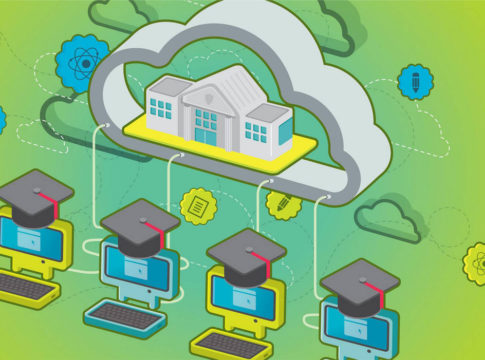Online, or digital, learning is continuing to grow, and as it does so, state legislatures are increasingly taking notice. In 2012, state governors signed more than 150 bills related to K–12 digital learning into law. My latest piece, Digital Roundup, in the Fall 2013 issue of Education Next takes stock of how state legislatures are seeking to shape, propel, and in some cases, stunt its growth in 2013.
There are a few key takeaways in the piece.
First, it is increasingly clear that the growth of online learning in K–12 will be different from the growth of online learning in higher education. Whereas in higher education, online learning poses an existential threat to many traditional colleges and universities, in K–12, online learning appears to be a sustaining innovation to public K–12 schools, as it is growing within, largely in blended-learning environments. Within public secondary schools, online learning does appear disruptive relative to traditional classrooms.
Second, there has been an uptick in the last few years of so-called “course choice” bills, in which dollars follow students down to the online course of their choice offered by a menu of providers, and the states pay the online provider part of the cost only when the student has successfully completed the course. Utah, Louisiana, Florida, Texas, and Michigan now all have various forms of course choice in law. My take is that this is a positive development, but it is important to realize that with the exception of courses in states where successful completion requires also passing a third-party end-of-course exam, these bills are largely incentivizing student completion, not necessarily student performance. That means there may be incentives to lower standards so that more students complete and pass classes and providers can receive all possible funds. It’s still arguably more accountable than the traditional system that only pays for the minutes a student sits in a seat, but the field would be smart to recognize that there are some dangerous incentives being created.
Third, states are increasingly capping the growth of, or even banning completely, statewide or multi-district full-time virtual schools, which are often created as charter schools. In the school year ending in 2013, 31 states allowed full-time, multidistrict online schools, and in the year before that these schools served roughly 275,000 students. But states, including Tennessee, Illinois, Maine, Pennsylvania, and New Jersey, are cracking down or giving close scrutiny to their continued growth. Digital learning advocates have often been happy to vacate the fight on behalf of full-time virtual schools, as they recognize that the majority of students in the future will likely be educated in blended-learning environments and blended-learning schools are likely to be most palatable to the general public, as well as unions and school boards. Actions in New Jersey though suggest that this is a mistake. In a state that does not permit multi-district full-time virtual schools, the New Jersey Education Association took advantage of their absence to file a lawsuit against two blended-learning charter schools that opened the previous fall. Absurdly enough, the lawsuit alleged that, in essence, the schools should not be allowed to operate because they were virtual schools, even though they were not. Although the union lost the suit, the fight has continued. It appears that full-time virtual charter schools are essential to the broader digital-learning movement because they absorb the opposition’s main line of attack. In the absence of full-time virtual schools, teachers unions and other opponents use their resources to attack blended-learning charters, even though the latter do not differ in legal structure, brick-and-mortar presence, or enrollment practices from other charter schools. Digital learning advocates’ best move would appear to be to fight for the allowance of all forms of digital learning with a strong focus on student outcomes that insures that low-performing schools of all stripes cannot grow and persist.
Finally, increasing numbers of states are trying to do away with antiquated seat-time regulations and move toward competency-based learning policy and regulatory frameworks, in which a student only progresses once he or she has demonstrated mastery of a concept or skill. Three years ago when I mentioned competency-based, or mastery, learning to a state legislator, I invariably received blank stares. Today the term increasingly means something to them, and they are recognizing its importance in creating a student-centered education system. Much of this action in states is occurring in departments of education through regulation, but Alabama, Florida, Idaho, Texas, Utah, and Vermont all took strides forward this year through new legislation.
Although digital learning continues to grow, how it grows and whether it fulfills its potential to create a student-centered education system are questions. The actions of state legislatures will inevitably shape part of the answer.
-Michael Horn
For more by Michael Horn, please read “The Transformational Potential of Flipped Classrooms,” from the Summer 2013 issue of Education Next.





